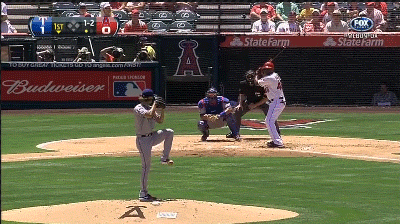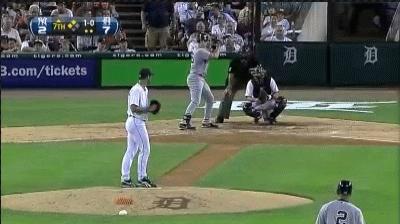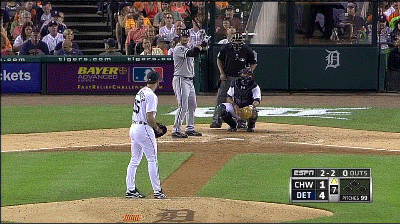We’re reached the culmination of the baseball season, having nearly consumed the 2012 textbook, and it’s time to test our knowledge. So let us begin the Final Exam for our Pitchology class.
We have covered a multitude of topics this semester, including mechanics, stuff, and injuries. We have studied a combination of case studies, player comparisons, and some of the theoretical concepts that underlie the mystery of pitching. Please refer to your notes and/or the textbook as you take the exam.
Exams will be graded on a curve from 20-80. Any questions will be handled during office hours in the comment section. Good luck. (The answer key can be found in the first comment.)
1. Which of the following is an advantage of a deep release point?
A) increased perceived velocity
B) less time for air drag
C) later movement on breaking pitches
D) all of the above
E) A & B only
2. Which strategy is most efficient for striding down the mound?
A) slow and steady wins the race
B) stay balanced with strong momentum throughout
C) use two gears, separated by max lift, starting slow and finishing fast
D) go as fast as humanly possible
E) C & D
3. Which strategy is most efficient for choosing a stride direction?
A) stride straight at the plate
B) stride closed
C) stride open
D) anchor on pitcher signature and adjust accordingly
E) alter the stride based on the location of the target
4. What is meant by the term, “foot strike”?
A) A strike that is aimed at the batter's foot
B) The time-point in a pitcher's leg lift when he strikes the foot out toward the batter
C) The time-point at which the pitcher's landing foot strikes the ground
D) A strike that is called on a baseball that has been doctored with shoe polish
E) The time-point at which a pitcher's drag foot leaves the ground
5. What nasty pitch is Yu Darvish throwing in the GIF below?

A) slider
B) cutter
C) slutter
D) splitter
E) whatever Yu wants to call it
6. If a pitcher has outstanding torque, it will most likely lead to:
A) great velocity
B) great command
C) great power from the rear axle
D) all of the above
E) A and B only
7. The momentum grade on the mechanics report card is most closely linked to which one of the other grades?
A) release distance
B) balance
C) posture
D) torque
E) B and C
8. Which of the following is a candidate to contribute to a pitcher's injury?
A) workloads
B) mechanics
C) functional strength
D) genetics
E) all of the above
9. The common emphasis on downhill plane:
A) has a dramatic impact on groundball rates
B) helps to minimize platoon splits
C) can have a ripple effect on release distance
D) is the reason why 6'10” Randy Johnson was so dominant
E) all of the above
10. Match the following series of photographs with the progression of posture grades listed below:
.png)
.png)

A) 50-35-70
B) 35-50-70
C) 35-70-50
D) 70-50-35
E) 50-50-50
11. The most critical grade on the Mechanics Report Card is:
A) balance
B) timing
C) torque
D) release distance
E) momentum
12. The most volatile grade on the Mechanics Report Card is:
A) balance
B) timing
C) torque
D) release distance
E) momentum
13. Which of the following is NOT a likely consequence of a pitcher using a slide step from the stretch?
A) a shallower release point
B) less time for an opposing baserunner to steal a base
C) improved pitch command
D) an increase of momentum
E) a disruption to the pitcher's natural timing
14. Why doesn't every pitcher throw a knuckleball?
A) it's really hard to throw a good knuckler
B) the pitch has to survive on its own
C) it works only under a full moon
D) A & B
E) A & C
15. What is the approximate effective velocity of the following pitch to Mark Teixeira (radar gun reading = 97 mph)?

A) 90 mph
B) 94 mph
C) 97 mph
D) 100 mph
E) 104 mph
16. What is the approximate effective velocity of the following pitch to Mark Teixeira (radar gun reading = 98 mph)?

A) 91 mph
B) 95 mph
C) 98 mph
D) 101 mph
E) 105 mph
17. Which is the best indicator of a pitcher's command?
A) frequency of hit targets
B) frequency of hits surrendered
C) frequency of hit batsmen
D) frequency of strikes thrown
E) frequency of pitches thrown over the plate
18. Which of the following is a common mechanical trend that is specific to LOOGYs?
A) use a closed stride
B) start on the first-base side of the rubber
C) throw “over the top”
D) A & C only
E) B & C only
19. Which of the following sequences is most efficient with the kinetic chain?
A) max lift → hip thrust → foot strike → fire hips → fire shoulders → stabilize glove → release point
B) max lift → fire hips → foot strike → hip thrust → fire shoulders → release point → stabilize glove
C) hip thrust → max lift → fire hips → fire shoulders → foot strike → release point → stabilize glove
D) hip thrust → max lift → fire hips → foot strike → fire shoulders → stabilize glove → release point
E) fire hips → hip thrust → max lift → foot strike → fire shoulders → release point → stabilize glove
20. Which elements of his mechanics help make Justin Verlander the best pitcher in the game?
(please refer to the GIF below)

A) plus balance and posture
B) plus timing and repetition
C) plus momentum
D) plus torque
E) all of the above, Plus
Free Response: If you were to ask the professor to evaluate any pitcher in baseball during the offseason, whom would you choose?
(Please use the comments section to submit your response)
Thank you for reading
This is a free article. If you enjoyed it, consider subscribing to Baseball Prospectus. Subscriptions support ongoing public baseball research and analysis in an increasingly proprietary environment.
Subscribe now
D-B-D-C-E-A-A-E-C-A-B-B-C-D-B-D-A-A-D-E
Matt Moore.
Small wonder I was a mediocre pitcher with a short-lived arm.
Great series, Doug. As with many thing baseball, wish I knew this "stuff" years ago.
My thoughts on a pitcher was Casey Janssen.
What an awesome story.
We should nickname him "Q&E" - describes his pace as well as his mechanics.
Looking forward to many more Raising Aces in the future. This year was excellent.
I like old/new comparisons. Say, Cy Young era Zito with bad Zito. Fister and McCarthy, too, who've found success by changing approaches.
Thanks for all of the great articles this season, Doug!
I am stoked on the idea of looking at some of the greats of the previous generation to breakdown why they were so good. The fascinating thing is that, even though guys like Randy and Pedro appear to be completely different, they actually share a ton of mechanical similarities.
PS Randy Johnson's Mechanics Report Card is almost perfect.